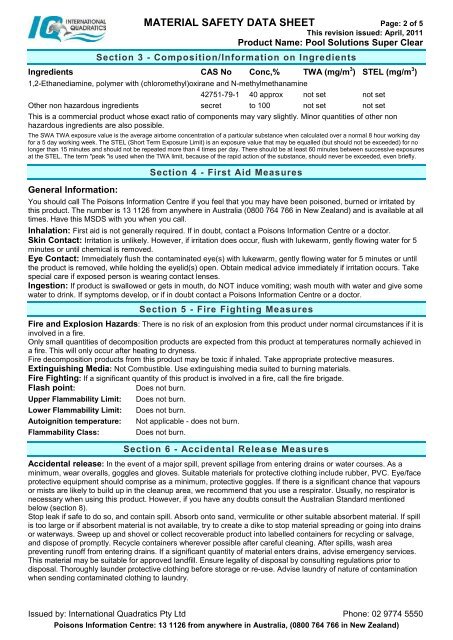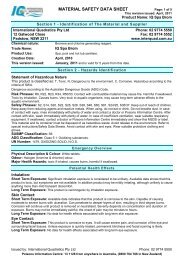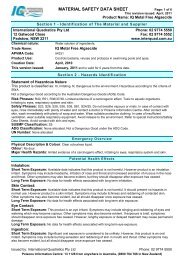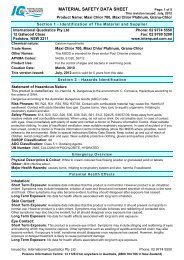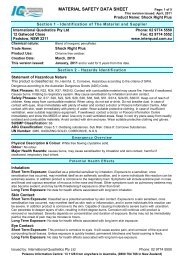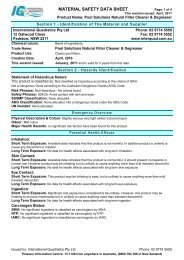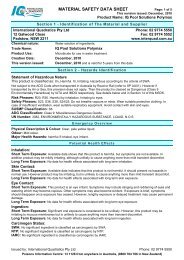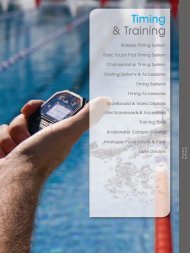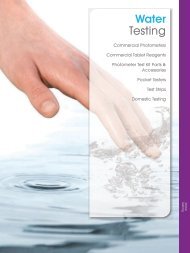IQ Pool Solutions Super Clear
IQ Pool Solutions Super Clear
IQ Pool Solutions Super Clear
- No tags were found...
You also want an ePaper? Increase the reach of your titles
YUMPU automatically turns print PDFs into web optimized ePapers that Google loves.
MATERIAL SAFETY DATA SHEET Page: 2 of 5This revision issued: April, 2011Product Name: <strong>Pool</strong> <strong>Solutions</strong> <strong>Super</strong> <strong>Clear</strong>Section 3 - Composition/Information on IngredientsIngredients CAS No Conc,% TWA (mg/m 3 ) STEL (mg/m 3 )1,2-Ethanediamine, polymer with (chloromethyl)oxirane and N-methylmethanamine42751-79-1 40 approx not set not setOther non hazardous ingredients secret to 100 not set not setThis is a commercial product whose exact ratio of components may vary slightly. Minor quantities of other nonhazardous ingredients are also possible.The SWA TWA exposure value is the average airborne concentration of a particular substance when calculated over a normal 8 hour working dayfor a 5 day working week. The STEL (Short Term Exposure Limit) is an exposure value that may be equalled (but should not be exceeded) for nolonger than 15 minutes and should not be repeated more than 4 times per day. There should be at least 60 minutes between successive exposuresat the STEL. The term "peak "is used when the TWA limit, because of the rapid action of the substance, should never be exceeded, even briefly.General Information:Section 4 - First Aid MeasuresYou should call The Poisons Information Centre if you feel that you may have been poisoned, burned or irritated bythis product. The number is 13 1126 from anywhere in Australia (0800 764 766 in New Zealand) and is available at alltimes. Have this MSDS with you when you call.Inhalation: First aid is not generally required. If in doubt, contact a Poisons Information Centre or a doctor.Skin Contact: Irritation is unlikely. However, if irritation does occur, flush with lukewarm, gently flowing water for 5minutes or until chemical is removed.Eye Contact: Immediately flush the contaminated eye(s) with lukewarm, gently flowing water for 5 minutes or untilthe product is removed, while holding the eyelid(s) open. Obtain medical advice immediately if irritation occurs. Takespecial care if exposed person is wearing contact lenses.Ingestion: If product is swallowed or gets in mouth, do NOT induce vomiting; wash mouth with water and give somewater to drink. If symptoms develop, or if in doubt contact a Poisons Information Centre or a doctor.Section 5 - Fire Fighting MeasuresFire and Explosion Hazards: There is no risk of an explosion from this product under normal circumstances if it isinvolved in a fire.Only small quantities of decomposition products are expected from this product at temperatures normally achieved ina fire. This will only occur after heating to dryness.Fire decomposition products from this product may be toxic if inhaled. Take appropriate protective measures.Extinguishing Media: Not Combustible. Use extinguishing media suited to burning materials.Fire Fighting: If a significant quantity of this product is involved in a fire, call the fire brigade.Flash point:Does not burn.Upper Flammability Limit: Does not burn.Lower Flammability Limit:Autoignition temperature:Flammability Class:Does not burn.Not applicable - does not burn.Does not burn.Section 6 - Accidental Release MeasuresAccidental release: In the event of a major spill, prevent spillage from entering drains or water courses. As aminimum, wear overalls, goggles and gloves. Suitable materials for protective clothing include rubber, PVC. Eye/faceprotective equipment should comprise as a minimum, protective goggles. If there is a significant chance that vapoursor mists are likely to build up in the cleanup area, we recommend that you use a respirator. Usually, no respirator isnecessary when using this product. However, if you have any doubts consult the Australian Standard mentionedbelow (section 8).Stop leak if safe to do so, and contain spill. Absorb onto sand, vermiculite or other suitable absorbent material. If spillis too large or if absorbent material is not available, try to create a dike to stop material spreading or going into drainsor waterways. Sweep up and shovel or collect recoverable product into labelled containers for recycling or salvage,and dispose of promptly. Recycle containers wherever possible after careful cleaning. After spills, wash areapreventing runoff from entering drains. If a significant quantity of material enters drains, advise emergency services.This material may be suitable for approved landfill. Ensure legality of disposal by consulting regulations prior todisposal. Thoroughly launder protective clothing before storage or re-use. Advise laundry of nature of contaminationwhen sending contaminated clothing to laundry.Issued by: International Quadratics Pty Ltd Phone: 02 9774 5550Poisons Information Centre: 13 1126 from anywhere in Australia, (0800 764 766 in New Zealand)


